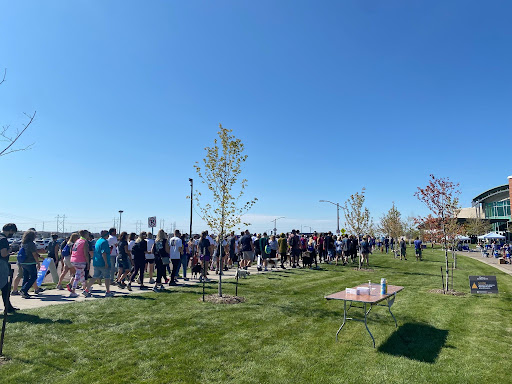Hundreds of people gather at the Scheels Arena in Fargo but this time, it isn’t for a Fargo Force game.
The gathering is for the 16th annual Out of the Darkness Walk. It is a fundraising event that brings awareness to suicide and suicide prevention. Registration is free and if one is willing, they can raise money for the cause.
Last year, the walk could not take place in person due to COVID-19. Like most community events, it was held virtually.
People of all ages and abilities showed up. Some were in their everyday clothes, others in gym clothes and some big groups were wearing matching shirts supporting a person they know that may have died or is suffering. Some people brought their children and others brought their dogs. The one thing all these people had in common, though, is why they are there.

“We come together as a community to connect by a common experience to listen, support, and care for one another,” said Mary Weiler during her speech before the walk commenced.
That common experience is suicide.
Suicide is the tenth leading cause of death in the U.S. About 33% of people personally know someone who died by suicide. September is Suicide Awareness month.
Before the walk, a band played some tunes, including Bob Dylan’s “Forever Young.” After their last song, the MC introduced Mary Weiler, the head of the American Foundation for Suicide Prevention (AFSP) chapter for North Dakota.
Weiler’s daughter died by suicide in 2005. Around that time, her other daughter found out about the AFSP’s Out of the Darkness Walks and contacted them saying her family wants to help bring more awareness and start the first Out of the Darkness in Fargo.
The first walk was held on Sept. 26, 2006. The following year in May, the AFSP-ND was started.
“One of the greatest gifts is speaking out for those who can’t,” said Weiler.
After Weiler’s speech, there was an explanation about the colored beads. The MC would introduce someone who is representing a certain color of beads and tell their story on why they are wearing them.
The colors are white, red, gold, orange, purple, silver, green, teal and blue. Each color represents a personal connection to the cause. Many people at the event can be seen wearing one or more of these colored beaded necklaces.
Concordia College’s student athletes could also be seen at the event whether they were volunteering or participating in the walk.
Two students that helped bring attention to the event to the athletes on campus are Caitlin Culleton and Brock Montgomery. They are part of the leadership committee for the Student Athletic Advisory Committee also known as SAAC.
“People commonly say that there is a stigma around mental health and I think we are doing a better job at getting rid of that and educating people on it,” said Montgomery who plays on the Concordia men’s hockey team.
Montgomery believes that to help combat the stigma, more money and programs should be going into mental health research and programs that help those who are struggling with it.
“I come from a community that has lost a lot of people to suicide, especially in the last five to ten years. I think this event really hits close to home for those who live around there,” said Culleton, a softball player at Concordia.
Culleton is from Warroad, MN, where there have been at least four deaths by suicide in the past three years. The Max Foundation was started after one of the deaths. The foundation partners with other mental health education and suicide prevention groups to help bring awareness in their area.
“One thing the AFSP does with the money is offer education programs to communities and specific groups,” said Montgomery.
Concordia athletes are going to be a part of those groups. SAAC is working with the athletes and giving educational classes to them about what to do when they see signs of depression and where to go if someone is struggling.
Suicide awareness and prevention have been becoming more of a common subject in recent years as people are trying to end the stigma around mental health. Ninety-three percent of people believe that suicide can be prevented, according to AFSP.

